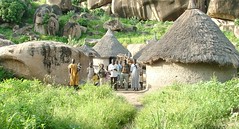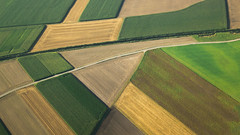Recently, some thoughts have arisen in the lab I belong to about a different way to think of cities: as human habitat, modified by humans through all our ecological behavior to suit us.
It's a given that all species alter their habitat. They may do this through herbivory, nest building, tunneling, alteration of biogeochemical cycles, even by changing the local climate. The impacts of many species are relatively minor compared on their own. A handful of species directly produce large changes in their environment through their behavior that other organisms have to reckon with. Beavers, elephants, and humans spring to mind. For the bulk of our few million years on the planet hominins have been no more of a force to reckon with than most other species.
Even after the emergence of Homo sapiens sapiens--possibly the most versatile and hardy animal to grace the face of the Earth--we didn't tend to have too outsize an impact. We may have cleared some land, burned grasslands in a purposeful way, and eaten a number of species into extinction, but we have otherwise lived within our niche as omnivorous apex predators without massively disturbing the Earth at large.
This would largely seem to be because humans historically lived in a relatively integrated manner within other ecosystems, making both intensive and extensive use of resources as necessary, and often being highly mobile (whether residentially or logistically). The high mobility and relatively small numbers of humans kept us from doing too much damage to the ecosystems we inhabited. Our versatility and cleverness occasionally enabled us to abuse our surroundings in ways other species cannot. After all, wolves can't switch to shellfish and tubers after all the giant flightless birds have been eaten.
As we moved towards cultural sedentism and an agrarian lifestyle, the degree to which we altered the landscape would seem to have intensified. Larger and larger patches of landscape became entirely dominated by humans to support increasing populations, and at some point in the neighborhood of 5,000 years ago conurbations appeared as a unique land use. We'll probably never know exactly why, other than that humans like to group together, many of us seem to like living in dense groups, and there does seem to be definite advantages to city dwelling for us as a species. Urban environments represent one of the apexes of human modification of the environment, and are steadily becoming the dominant form of human habitat.
Humans currently occupy three "types" of habitat, to varying degrees: (1) Integrated, (2) urbanized, and (3) support.
 |
| Villiage, by Vit Hassan |
 |
| Chicago (ILL) Willis Tower ( Ex. SEARS Tower ) 1974, east side "the loop ", by vincent desjardin |
 |
| German Fields, by mike maccaffery |
I should be clear that I don't believe any of these are as clear and simple as they are written and represented as here. Not every bit of urban habitat is downtown Chicago, and not every piece of support habitat is an intensive monoculture. Nor is every integrated habitat self sufficient or "in harmony" with nature (as we tend to think about these things, which I challenge).
On this point especially I should be very clear: None of these habitats is more "natural" than any other. They are all the result of Homo sapiens sapiens altering habitat to suit its needs. There is nothing unnatural about the built environment or agricultural monocultures. They may not be sustainable, or particularly stable without intensive energy inputs, but this is not to say that they are unnatural. One might even view them only as disturbed to the extent that the ability of other species to meet their needs is disrupted. After all, a beaver must constantly repair its dam, and leaf cutter ants work like crazy to keep their fungal gardens supplied with leaves and at just the right temperature and humidity. From the perspective of the beaver or the colony of ants, they do not disturb the ecosystem, particularly since the organisms and landscapes that have evolved with them have developed ways to accommodate their activities.
Okay, so perhaps humans have three types of habitat. What of it? The big idea here, the thing worth thinking about, is that the idea of treating cities and their support systems as human habitat may be an important way of reconciling "human" systems and "natural" systems. It allows us to explicitly look at the functions of the city (be they social, economic, or what have you) in terms of human habitat needs. Does a policy make a city more suitable for successful habitation by humans, or less? Does it reduce the load on support landscapes, or increase it? Can we understand the movement of humans in terms of habitat suitability? Thinking of cities in this way may allow us to bring many of the tools of traditional ecology to bear on humans in interesting ways.
It definitely something I will be thinking about in the near future.
No comments:
Post a Comment